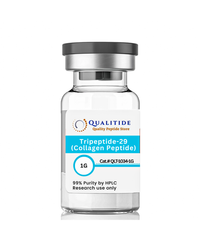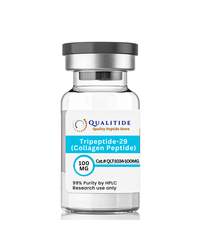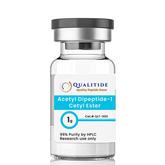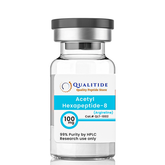Product Usage: This PRODUCT, exclusively offered by Qualitide, is for RESEARCH USE ONLY. It is intended for in vitro testing and laboratory experimentation. All information on this website serves educational purposes only. Introducing this product into humans or animals is illegal. It must be managed by licensed professionals only. This is not a drug, food, or cosmetic and should not be branded or misused as such.




Description
xTripeptide-29 is a synthetic biomimetic peptide that significantly improves collagen synthesis promoting wrinkle reduction, firming, and skin plumping. It is known under the trademark AC Collagen Prepeptide PF.
Collagen is a long-chain polymer made of short monomeric repeats that are generally made up of three amino acids in sequences. Collagen subunit almost always follow the pattern of Gly-Pro-X or Gly-X-Hyp. Tripeptide-29 is a Gly-Pro-Hyp peptide, making it a perfect synthetic analogue of common collagen building blocks. Thanks to a small molecular weight of 285 D, Tripeptide-29 exhibits increased bioavailability and easily penetrates deeper layers of the skin. Reaching dermal fibroblasts, stimulates those cells enhancing collagen synthesis activity.
Increased collagen production improves DHJ (dermal-epidermal junction) integrity and scaffolding matrix. Tripeptide-29 is a safe and effective ingredient for anti-aging preparations formulated to boost collagen production and expose a youthful, healthy, and radiant appearance. It is usually used in 0.1 – 1.0% concentration.
Chemical Formula: C12H19N3O5
Molecular Weight: 285.3 g/mol
Amino Acid Sequence: Gly-Pro-Hyp
CAS#: 2239-67-0
Fundamentally, tripeptide-29 acts as a building block of larger collagen molecules. In so doing, it can change, by virtue of its amino acid sequence and relative frequency with the collagen superstructure, the tertiary and quaternary properties of a collagen molecule. Collagen is not just a structural protein, but also plays roles in cell adhesion, tissue regulation, and healing. Thus, tripeptide-29 has the potential to impact a multitude of physiologic features.
Tripeptide-29 Research
In vitro research into tripeptide-29 has revealed that the peptide, in its non- polymerized form, is a partial agonists of the collagen receptor GPVI[1]. GPVI is expressed on the surface of platelets, the cell-like structures responsible for the early formation of blood clots. The GPVI receptor plays a crucial role in the collagen-induced activation of platelet aggregation in vascular tissue, a first step to clot formation and tissue repair. Thus, collagen fibers are generally considered thrombogenic.
When dysregulated, collagen thrombogenesis may lead to the development of blood clots. Interestingly, crosslinking of tripeptide-29 appears to boost GPVI activation, suggesting that the peptide could be useful in understanding how to create a “just- right” clotting environment in the setting of various bleeding/clotting disorders.
Tripeptide-29 and Collagen Stability
Benchtop research into the role of short peptides like tripeptide-29 has revealed that they can be used to modulate the stability of collagen. Tripeptide-29, in particular, has helped scientists to understand that the ultimate structure of collagen is influenced most by the last peptide in a tripeptide monomer. In a monomer of A-B-C, it is the peptide in the C position that has most influence on final collagen stability[2]. This finding could help scientists to one day create synthetic implants for cartilage, bone, teeth, and more.
Collagen and Free Radical Damage
Free radical damage is the primary cause of cellular and tissue aging. The body has a number of defenses against free radical damage, but they all become less effective over time.
Research in sea cucumber has revealed that collagen hydrolysates constructed from monomers like tripeptide-29 are effective radical scavengers, and that the structure of the tripeptide monomer can affect scavenger activity. No research has been carried out on Tripeptide 29, yet, but there is interest in determining how such peptides could be used in foods and nutraceutical products[3].
Tripeptide-29 Regulates Tissue Fibrosis
In vitro studies of pig skin, cattle skin, fish scales, and chick feet have revealed that tripeptide-29 is an inhibitor of dipeptidylpeptidase-IV activity[4], [5].
Dipeptidylpeptidase-IV (DPP4) is an enzyme found mostly in cells associated with immune signaling and cell apoptosis. It is an intrinsic part of the cell membrane and indiscriminately destroys growth factors, chemokines, neuropeptides, and vasoactive peptides. It also plays a large role in glucose metabolism by breaking down incretins, hormones that stimulate a decrease in blood glucose levels.
Animal studies have revealed that DPP4 plays a role in the development of fibrosis in organs that include the kidney and liver[5]. Inhibiting the enzyme thus prevents scarring in disease processes that affect these organs. Tripeptide-29 maybe doubly beneficial in this setting, as diabetes is a prime cause of kidney fibrosis. The ability of Tripeptide-29 to stimulate glucose uptake and reduce fibrosis, both by inhibiting DPP4, opens a number of research avenues in the control of not just diabetes, but its pathologic sequelae as well.
Tripeptide-29 and Skin Tone
There is recent interest in the role of tripeptide-29 and other tripeptides in protecting skin against the normal process of aging. Research in animals suggests that topical use of tripeptides can reduce the visible effects of skin aging by improving contour, reducing skin deformation, and boosting hydration. There is also evidence that tripeptides can smooth skin texture and reduce the appearance of brown and red spots. In fact, 90% of subjects in the study showed improved moisturization of the skin in addition to increased flexibility secondary to improve elasticity[6].
When combined with certain hexapeptides, topical tripeptide-29 can boost skin turnover and reduce fine lines, crow’s feet, under eye bags, and eye hollowing. In these animal studies, roughly 50% of subjects showed improved skin appearance with twice daily application of the peptide paste[7].
Reference
1. J. Asselin, C. G. Knight, R. W. Farndale, M. J. Barnes, and S. P. Watson, “Monomeric (glycine- proline-hydroxyproline)10 repeat sequence is a partial agonist of the platelet collagen receptor glycoprotein VI,” Biochem. J., vol. 339 (Pt 2), pp. 413–418, Apr. 1999.
2. K. Mizuno, D. H. Peyton, T. Hayashi, J. Engel, and H. P. Bächinger, “Effect of the -Gly- 3(S)-hydroxyprolyl-4(R)- hydroxyprolyl- tripeptide unit on the stability of collagen model peptides,” FEBS J., vol. 275, no. 23, pp. 5830–5840, Dec. 2008.
3. M. Z. Abedin et al., “Biochemical and radical-scavenging properties of sea cucumber (Stichopus vastus) collagen hydrolysates,” Nat. Prod. Res., vol. 28, no. 16, pp. 1302–1305, 2014.
4. T. Hatanaka, K. Kawakami, and M. Uraji, “Inhibitory effect of collagen-derived tripeptides on dipeptidylpeptidase-IV activity,” J. Enzyme Inhib. Med. Chem., vol. 29, no. 6, pp. 823–828, Dec. 2014.
5. H. S. Min et al., “Dipeptidyl peptidase IV inhibitor protects against renal interstitial fibrosis in a mouse model of ureteral obstruction,” Lab. Investig. J. Tech. Methods Pathol., vol. 94, no. 6, pp. 598–607, Jun. 2014.
6. A. Garre, G. Martinez-Masana, J. Piquero-Casals, and C. Granger, “Redefining face contour with a novel anti-aging cosmetic product: an open-label, prospective clinical study,” Clin. Cosmet. Investig. Dermatol., vol. 10, pp. 473–482, 2017.
7. Reivitis, K. Karimi, C. Griffiths, and A. Banayan, “A single-center, pilot study evaluating a novel TriHex peptide- and botanical- containing eye treatment compared to baseline,” J. Cosmet. Dermatol., vol. 17, no. 3, pp. 467–470, Jun. 2018.
Shipping & Return
xReturns Policy
At Qualitide, we are committed to ensuring your satisfaction with our products. Our Satisfaction Guarantee policy allows you to return or exchange any item within 14 days of receiving your order if you are not completely satisfied. Return/Exchange Eligibility To be eligible for a return or exchange: The item must be in its original condition as received, unworn or unused, with tags attached, and in its original packaging. You must provide the receipt or proof of purchase..
If you need to return an item, simply login to your account, view the order using the "Complete Orders" link under the My Account menu and click the Return Item(s) button. We'll notify you via e-mail of your refund once we've received and processed the returned item.
Shipping
At QUALITIDE, we aim to make your shopping experience simple and smooth. Here’s how we handle shipping: Processing Time We process all orders within 0 to 1 business day. Orders placed after business hours, on weekends, or on holidays will be processed the next business day. Delivery Time Once processed, delivery takes 2 to 3 business days, depending on your location and the shipping carrier. Total Delivery Time From placing your order to receiving it, the total time is 2 to 4 business days, including both processing and shipping.
Disclaimer
xAll articles and product information provided on this website are for informational and educational purposes only. The products offered on Qualitides are intended solely for in-vitro research purposes. In-vitro studies ("in glass" studies) are conducted outside of the body. These products are not medicines or drugs and have not been evaluated or approved by the FDA to prevent, treat, diagnose, or cure any medical condition, ailment, or disease. Any form of bodily introduction or administration of these products into humans or animals is strictly prohibited by law. By using this website, you acknowledge and agree to comply with all applicable regulations and restrictions related to the products provided by Qualitides.
- Choosing a selection results in a full page refresh.








